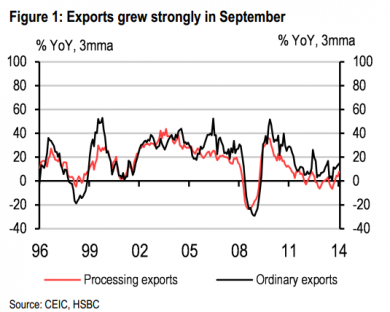A reported export surge in September is failing to dispel the gloom suffusing forecasts for China’s third quarter GDP growth, which several economists predict to slump to a five-year low.
中国9月出口飙升的报道未能驱散围绕第三季度国内生产总值(GDP)增长预测的悲观气氛——多位经济学家预计,第三季度GDP增速将跌至5年来的最低水平。

One problem lies with the export numbers themselves, which raise suspicions that over-invoicing may once again be artificially inflating export statistics as Chinese smuggle hot money into the mainland from Hong Kong to take advantage of an appreciating renminbi.
一个问题与出口数据本身有关。人们怀疑,高开发票行为可能再次人为推高了出口数据,因为一些中国人偷偷将热钱从香港带入内地,以利用人民币升值趋势。
“As in the past, over-invoicing is a key channel for hot money to enter China,” said Shen Jianguang, chief Asia economist at Mizuho Securities in Hong Kong. Shen noted that exports to Hong Kong rocketed by 34 per cent in September, the highest level seen since April 2013, when over-invoicing was considered to be rife.
瑞穗证券(Mizuho Securities)驻香港的亚洲首席经济学家沈建光表示:“和以往一样,高开出口发票是热钱进入中国内地的主要途径。”沈建光指出,9月内地对香港出口额飙升34%,为2013年4月以来最高水平——据信当时高开出口发票行为非常流行。
A survey of executives at 200 export companies, trading firms and shipping agents in China in September revealed that 54 per cent of respondents think over-invoicing of exports is resurgent, the highest levels since late 2013, according to China Confidential, a research service at the Financial Times.
根据英国《金融时报》旗下的研究性刊物《中国投资参考》(China Confidential),9月针对200家出口企业、贸易公司和船运代理商的高管调研显示,54%的受访者认为,高开出口发票现象再次升至2013年末以来最火热的水平。
According to official statistics announced on Monday (see chart), exports rose 15.3 per cent year on year in September, up from 9.4 per cent in August. Imports, meanwhile, climbed 7.2 per cent, up from a 2.3 per cent decline in August. The trade surplus hit an official US$30.9bn, down sharply from US$49.8bn in August.
周一公布的官方统计数据显示(见右图),9月出口同比增长15.3%,增幅高于8月的9.4%。进口增长7.2%,而8月下降2.3%。官方的贸易顺差数字为309亿美元,较8月的498亿美元大幅下降。
However, the resurgent export numbers were also at odds with what the International Monetary Fund’s (IMF) downward revision of its global economic growth forecast this year to 3.3 per cent from 3.4 per cent as it warned about weakness in Japan, Europe and Latin America.
中国出口数字飙升也与国际货币基金组织(IMF)下调全球经济增长预期的做法不一致。IMF警告,日本、欧洲和拉美各地经济均显露疲态,据此将今年全球增长预期从3.4%下调至3.3%。
In addition, China’s reported export resurgence does not correspond with various survey-based readings of export activity in September. The new export order sub-index of the official manufacturing Purchasing Managers Index (PMI) languished at around 50 points in September, indicating an expectation of scant growth.
此外,中国出口回暖与9月各项与出口活动相关的调查数据不一致。官方的制造业采购经理人指数(PMI)显示,9月份新出口订单分类指数徘徊在50点左右,这表明受访者预期增长乏力。
GDP projections in Q3 could slump to a five-year low
预测:第三季度GDP增长率可能跌至5年来低点
Several economists are issuing projections that could signify China’s weakest quarter of GDP growth since the 6.6 per cent it posted in the first quarter of 2009, as sliding investment in property, waning manufacturing activity and dwindling credit growth combine. Third quarter GDP is expected to be announced next week.
根据多位经济学家发布的预测数字,随着房地产投资下降、制造业活动减少和信贷增长萎缩,中国经济可能出现自2009年第一季度以来最弱的季度增长。2009年第一季度GDP增长6.6%。预计中国将在下周发布第三季度GDP数据。
Wang Tao, chief China economist at UBS, reckons third quarter GDP will slide to 7.1 per cent from an official 7.5 per cent in the second quarter and 7.4 per cent in the first. Jasper McMahon of London-based Now-Casting Economics sees a growth rate of 6.8 per cent, based on a statistical model. Craig Botham, emerging markets strategist at Schroders, sees a 7.3 per cent expansion, with a risk that the actual figure could come in lower. Tang Jianwei, an economist at the Bank of Communications, also sees a 7.3 per cent rate.
瑞银(UBS)中国首席经济学家汪涛预计第三季度GDP增长率将降至7.1%。官方公布的一季度和二季度GDP增速分别为7.4%和7.5%。伦敦Now-Casting Economics的贾斯珀•麦克马洪(Jasper McMahon)使用一个统计模型测算,估计增长率为6.8%。施罗德(Schroders)新兴市场策略家克雷格•博瑟姆(Craig Botham)预计增长率为7.3%,并认为实际数据可能更低。交通银行(Bank of Communications)经济学家唐建伟也预计增长率为7.3%。
Such projections come after several signs that growth in September was laclustre, with a series of China Confidential indicators on discretionary spending, labour demand by companies, export growth and freight volumes shipped either falling in the month or remaining at depresssed levels (see chart).
在这些经济学家发布预测之前,已有多个迹象显示9月份增长低迷。《中国投资参考》编制的可支配支出指数、企业用工需求、出口增长和货运量等一系列指标在当月不是下降,就是保持低迷(见下图)。
Such trends do not augur well for the rest of the year or 2015. “My feeling is that the growth target will be lowered again next year as they must have realised by now that it is hard to hit 7.5 per cent GDP growth without resorting to a stimulus that feeds their economic frailties,” said Craig Botham at Schroders.
此类趋势对今年剩余时间及2015年不是好兆头。施罗德的克雷格•博瑟姆(Craig Botham)表示:“我预感中国明年将再次下调增长目标,因为他们现在必定已经意识到,如果不采取刺激措施解决经济疲弱问题,就很难实现7.5%的增长。”
Botham added that Beijing was likely to adopt a “hard floor” for growth in 2015 of around 6.5 per cent but attempt to reach around 7 per cent. He added that China was unlikely this year to unleash a general stimulus measure by loosening credit and more likely to concentrate on targeted measures to boost affordable housing projects, lending by the larger banks, the provision of capital to small and medium enterprises and various infrastructure projects.
博瑟姆补充称,北京方面很可能将2015年增长率“底线”定在6.5%左右,但会争取达到7%左右。他说,中国今年内不太可能采取放松信贷之类的全面刺激措施,而是更可能着眼于有针对性的措施,如增加保障房项目,促进各大银行放贷,向中小企业提供资金以及上马某些基础设施项目。













